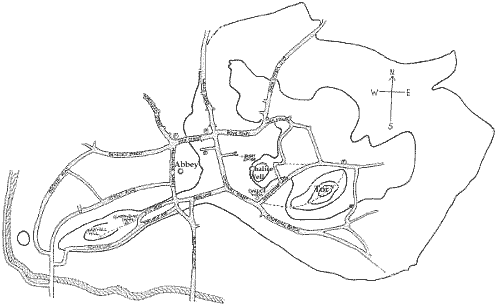Glastonbury Legends
Glastonbury, as the Isle of Avalon, was the Otherworld home of one of the Celtic Underworld Gods, Afallach. For the Celtic people, the Isle of Avalon was the location where one would go when near to death. Glastonbury is marked as the Isle of Avalon by its numerous ancient names like the 'Isle of Glass.' The Isle of Glass relates to Caer Wydyr or the name 'Fort of Glass,' which is another name for part of the Celtic Otherworld. However, the most direct relations come from the old Celtic legend about Glastonbury Tor. The Tor, the hill that dominates the Glastonbury landscape, was thought to be the entrance to Annwfn, the Celtic Otherworld, and the Palace of Gwynn ap Nudd, Afallach's brother and the main Otherworld god. Celtic legend also holds that the hill itself is hollow and that this in turn has led to the legends that it was the entrance to the Otherworld. The Celtic Ancestor Gods Beli Mawr the Great, God of the Sun Beli Mawr was the Celtic God of the Sun and is represented the curative powers of the Sun's heat. The festival of Beltane was held in his honor on the first day of May. Activities of the festival included bonfires to welcome the Summer and to encourage the Sun's warmth. Beli Mawr's symbols were the horse and the wheel. Like the Roman god Apollo, Beli Mawr was thought to drive the Sun in a horse drawn chariot across the sky. Several hills throughout Celtic England were associated with Belie Mawr at Cornwall, Devon and the Glastonbury Tor. Interestingly all these hills lie on a ley line that faces the Rising Sun on the day of Beltane. Don, Goddess of Fertility Don, Danu or Anu was a Mother-Goddess and the wife of Beli Mawr. Don is represented in the night's sky as Llys Don, better known as Casseopeia. Like Beli Mawr, Don is honored by several hills; in County Kerry's 'Breast of Anu' and in Leicestershire's 'Black Annis.' Don was the patroness of springs and fountains. In the Arthurian legend Don appears as Annowre, a sorceress who imprisoned Arthur in the Perilous Forest. Lludd Llaw Ereint the Silver-Handed, God of Health & Healing Lludd, also known as Nudd, was the Celtic God of Healing and was the son of Beli Mawr. Lludd had a large shrine at Lydney in Gloucestershire, where offerings of bronze diseased limbs were left. Lludd was identified with the protective and regenerative powers. Lludd's companion and symbol was a dog, a deerhound breed with a lick that could cure the diseased. According to legend, Lludd was once the leader of the gods but was wounded in battle and lost his hand. Gorfannon, the divine-smith god, made Lludd a new hand out of silver. For his defeat, Lludd lost his position to his nephew, Lleu Llaw Gyffes. Afallach, God of the Underworld Afallach was the son of Lludd Llaw Ereint and was one of the Celtic gods of the Underworld. Afallach ruled Avalon where he lived with his daughter, Modron, and her nine sisters. Avalon was like the Celtic heaven, a peaceful island far away where apples grew (for which it was named.) Afallach is known in the Arthurian legends as King Evelake. Arthurian Legends
According to the orginal tale 'Excalibur' was a name first used for King Arthur's sword by the French Romancers. Excalibur was not the famous 'Sword in the Stone', but a second sword that was later acquired by King Arthur after his previous sword broke in battle. Worried that Arthur would fall in battle, Merlin took Arthur to a magical lake near Avalon where a mysterious hand thrust itself up from the water holding Excalibur. It was the Lady of the Lake offering Arthur a magical, unbreakable blade, fashioned by an Avalonian elf smith (at Glastonbury), along with a scabbard which would protect him as long as he wore it. Towards the end of Arthur's reign when he was troubled by Medrod's rebellion, Excalibur was stolen by Arthur's wicked half-sister Morgan le Fay. The sword was later recovered but the scabbard was lost. As a result, Arthur was mortally wounded at the Battle of Camlann. Arthur then instructed Bedwyr to return Excalibur to the Lady of the Lake. Upon his return, Bedwyr told Arthur that he had seen nothing unusual. Realizing that Bedwyr did not return the sword, Arthur instructed him a second time to return the sword. At the waters near the Isle of Avalon, Bedwyr threw the sword into the lake and saw a hand appear to catch Excalibur and draw it below. A Site of Queen Guinevere's Prison King Melwas had abducted Guinevere to his stronghold at Glastonbury. King Arthur soon arrived to besiege the castle and save his queen. However, through different stories of the same tale either through negotiation or death by Lancelot, Guinevere was freed. King Arthur's and Guinevere's burial place Arthur was taken to the Isle of Avalon to be healed of his wounds after the Battle of Camlann. Tradition assumes that Arthur died and was buried in Avalon with his queen. However, there are no sources on the location of his grave. With Avalon association with Glastonbury, Arthur is believed to be buried on either the Tor, one of the surrounding cemeteries or on the Abbey grounds. Today, Glastonbury, which lies in the middle of Somerset, England, is miles away from the sea. However there was once a time when the local low farmlands were inidated with marshland. This would have left the Tor and the surrounding hills as islands. In 1190CE, the monks of Glastonbury Abbey claimed to have discovered the bodies of both King Arthur and Queen Guinevere in their ancient cemetery near the Lady Chapel. Christian Legends
Joseph was the biblical figure who took Jesus' body after the crucifixion. According to some legends he was actually Jesus' uncle, and had visited Britain years before with Jesus in the pursuit of his interests in the tin trade. It appears that there actually was a strong Jewish presence in the west of England at that time, and many of the tin miners may have been Jewish settlers. At any rate, when Jesus died, Joseph thought it prudent to flee Palestine, and after many travails he came to Britain with a company of followers. He brought with him the Holy Grail, the cup used by Jesus at the Last Supper. Some versions of the legend have it that the Grail contained two drops of blood captured from Jesus' side when he was wounded on the cross. Joseph was said to have established the first church in England at Glastonbury, and archaeological records show that there may well have been an extremely early Christian church here. What happened to the Holy Grail is another matter. The Holy Grail 
The Knights Templar were even once thought to possess and/or know of the Grail's whereabouts. Yet another legend claims that the Templar Knights had created a simple placemarker for the Grail's secret location. The riddled placemaker was a circular spiral that ended at the center. Along side the sprial was a Holy Roman Cross. The winding path of the Glastonbury Tor is thought to be the location the placemarker describes. The Glastonbury Thorn 
Other Legends Glastonbury, the magical Isle of Avalon, has also been home to an ancient and powerful Goddess of transformation and rebirth. The goddess appears in the myths and legends of this sacred place in the Sisterhood of the Nine Morgens, the most famous of whom is Morgen la Fey, the faerie half-sister to King Arthur. She is remembered as Brighde, Goddess of healing, poetry and smithcraft, who appears here in the swan-shaped landscape temple of Avalon and in the legends of St. Brigid, who visited Glastonbury in the sixth century. She also can be seen on misty mornings in the form of Rhiannon, the White Mare from the Seas, who rides the Hollow Hills of Avalon. 
|